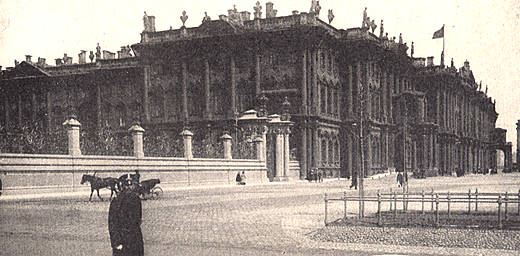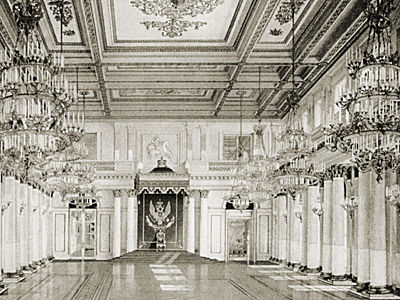   

There were many palaces built on this site, the first one, a small two storied building, was constructed for Peter the Great in 1711. The second Winter Palace was built in Dutch style a few years later. In 1732 Bartolomeo Rastrelli was asked to begin work on a completely new building. Rastrelli was the son of an Italian sculptor who had brought his 16 year old boy with him when he moved to Russia do work for the Imperial Court.
 Left: Elizabeth I. Left: Elizabeth I.
Rastrelli's project grew bigger and bigger. Finally, in 1754 Elizabeth I, daughter of Peter the Great, ordered Rastrelli to start over again with an entirely new style which came to be called "Elizabethan Baroque". Thousands of workman toiled on the new project, many of them soldiers. Workers with special skills, like masons and carvers, were called from all over the country to work on the new palace. The costs were so high that Rastrelli had to go to the State Senate to plead for funds for the completion of the structure. Rastrelli argued that this new palace would be the rival of any building in Europe and would place Petersburg - on par as far as palaces were concerned - with royal residences in France and Germany.
Rastrelli's building is very ornate - and huge - the grand proportions of the building are embellished with columns, capitals, urns and statues. Elizabeth was very pleased with the building which added to her grandeur and prestige. originally the Winter palace was painted a sand color with white. Today it is an apple green with white, slate-gray and gilt ornaments. In 1900, as seen here, it was painted a dull red.
To the right can be seen a wall with wrought-iron grillwork. The pilasters of this wall are topped by wrought-iron double eagles. This wall was designed by the Imperial Court Architect, Roman Meltzer, for Empress Alexandra Feodorovna, wife of the last Tsar Nicholas II. The wall enclosed a garden close to the wing where the Imperial family lived. Alexandra built this wall to give her children a place to play and also to push back the public from the palace. The windows of the Imperial family's rooms were on the second floor and many people used to stand and watch the windows for a possible glimpse of their rulers. The shy Alexandra found this disturbing. The wall, a unique work of art from the last years of the 19th century, was torn down after the revolution and a small part was moved and preserved at a new location on a popular street.  Above: The St. George Hall of the Winter Palace.
The interiors of the Winter Palace were spectacular and designed to impress. They were richly decorated in marble, gilt, silk and parquet. All of this splendor went up in flames in December 1837. Nicholas I and his wife, Alexandra, were at the theatre when they received news that their home was on fire. He rushed back to direct the rescue efforts. The fire was one of the biggest ever seen in the city. The heat from the fire made the statues on the roof toss and jump about, making them look like they were giants in some infernal dance above the palace. Men and soldiers risked their lives to save furnishings and works of art from the palace. The private possessions of the Tsar's family were dragged out from under the flames. The Empress's dressing table - with everything upon it - was brought out at great risk to the men that saved it. Unavoidably, precious objects were dropped along the way and lost in the confusion. The following spring, gold ornaments belonging to the Empress were found under the melting snow. After the fire ended, the Winter Palace was only a burned out shell.  Above: The Jordan Staircase in the Winter Palace.
Nicholas I decided he wanted the palace totally restored - and fast. Work began even before the ruins had cooled. Thousands toiled to recreate the building just as it was. By 1839 most of the major halls were recreated under the direction of the Russian architect, Stasov. People suspected the work was done too quickly - simply to meet unrealistic commitments made to Tsar Nicholas I. When the St. George's Hall was reopened the Tsar made a tour of it and was very pleased with the accomplishments of the his workmen. The room was splendidly redone and enormous chandeliers where lit to add sparkle and glamour to the room. Less than 24 hours after the Tsar had stood beneath the great chandeliers admiring the work, one of them came crashing down with part of the ceiling.
 Right: The Hall of 1812 in the Winter Palace. Right: The Hall of 1812 in the Winter Palace.
The Palace was a working Imperial residence and the many of the Tsars and Tsarinas made their home there. Thousands of servants worked at the palace to servethe needs of the Romanovs and their guests. The palace was so vast and labyrinth-like that there were curious corners where bizarre aspects of palace life took place unknown to the outside world. Few people knew about things such as the cows who lived on the roof and supplied fresh milk to the family. In the cellar was a vast wine cellar filled with thousands of the best European vintages. Elsewhere, the fabulous Russian crown jewels were tucked away in their own special room and there were hundreds of little service rooms where peculiar services took place - among them were upholstery, flower arranging, pie making, gift, china, and buffet rooms.
In 1900 the Tsar and his family still spent part of the year at the Winter Palace, although they didn't like the place very much. The palace was unsafe and noisy - it was impossible to guarantee the safety of the Tsar there. The Secret Police knew there were hundreds of doors and passages leading into the palace. Workmen, servants and tradesmen came and went all the time and this made the Secret Police fear terrorist attacks on the palace. Some years before a huge bomb had been constructed in the place by revolutionaries and Alexander II was lucky to have escaped unharmed, although many people died or were injured in the bombing.
Beside the danger of terrorism the plumbing was atrocious and a danger to the health of the Tsar's family. No mater what steps were taken, cases of typhoid, cholera and diphtheria were constantly being contracted in the palace.
Hundreds of people were coming and going constantly and every member of the aristocracy wanted to see stop by and see the Tsar or Tsarina. The Imperial Couple, however, much preferred the peaceful seclusion and quiet of Tsarskoe Selo and the Alexander Palace over the Winter Palace.
Next photograph: The Great Catherine Palace
For a small map of the St. Petersburg area click here.
To see a large map of the center
of St. Petersburg go here.
Comments on the website should be sent to Bob
Atchison. |
 |
|

